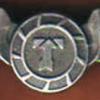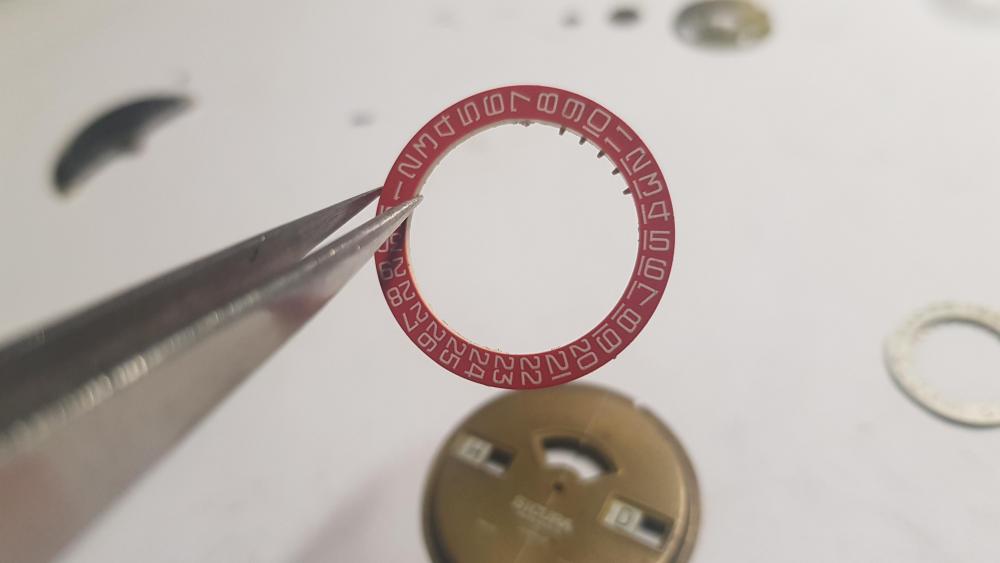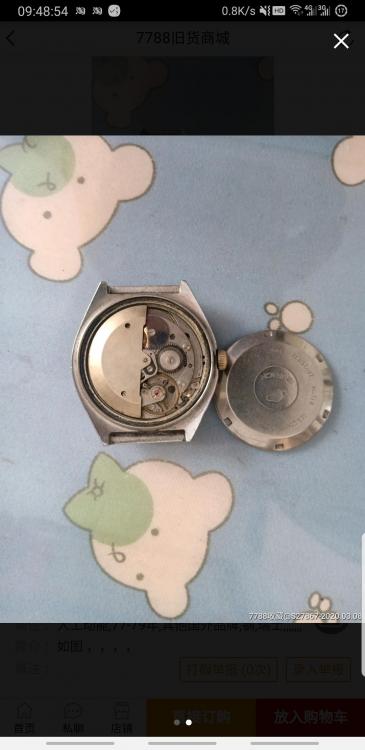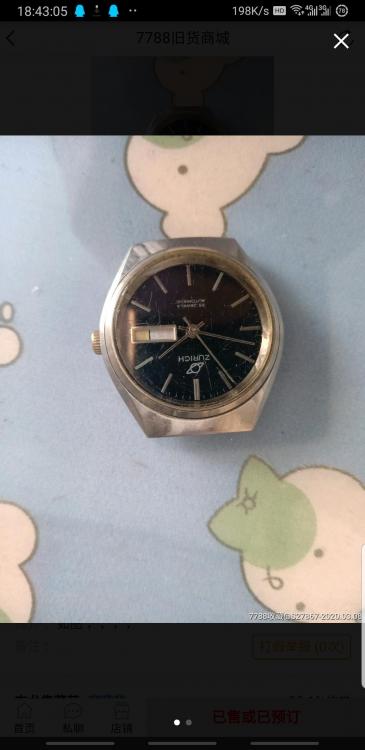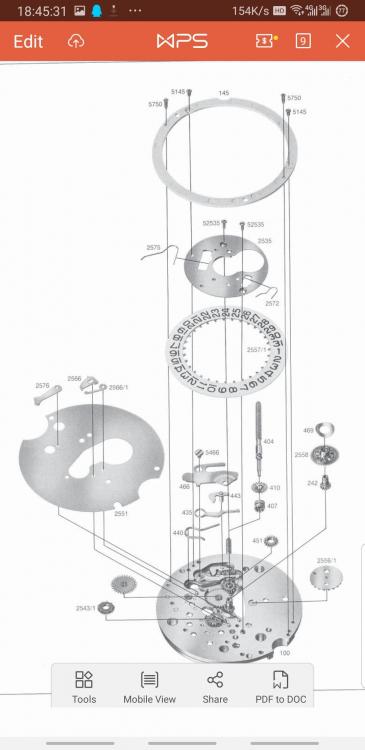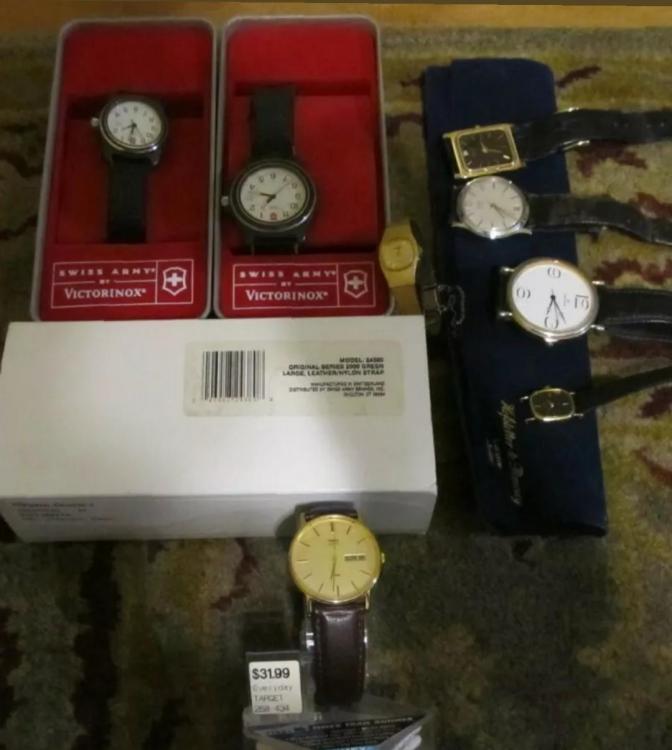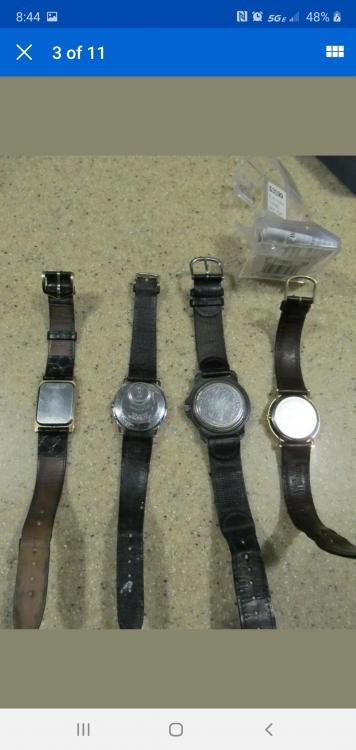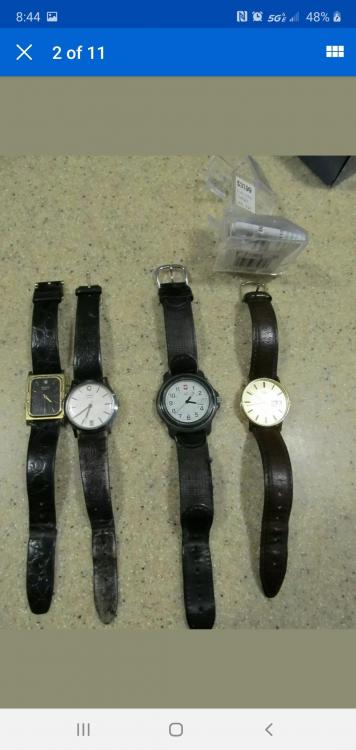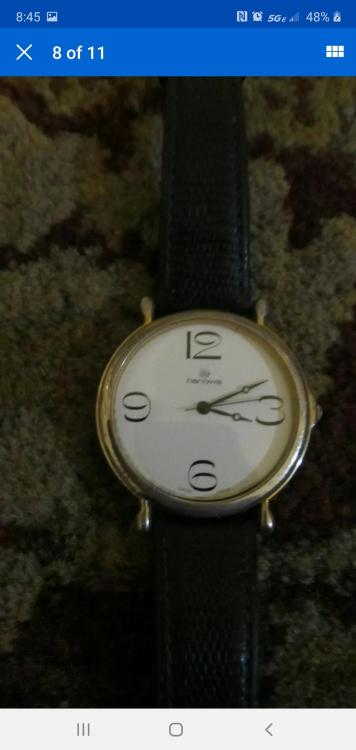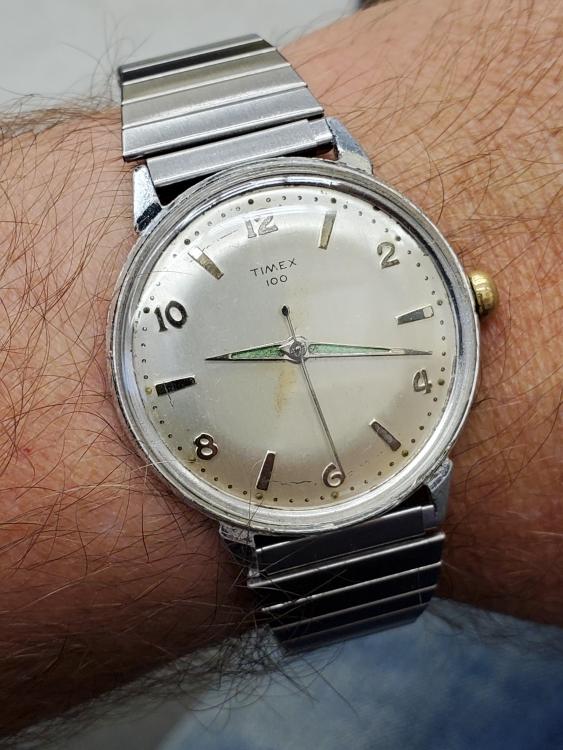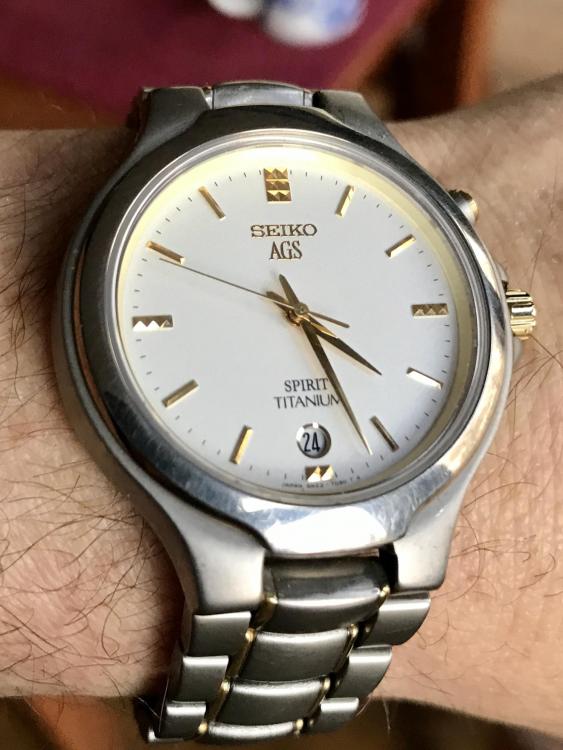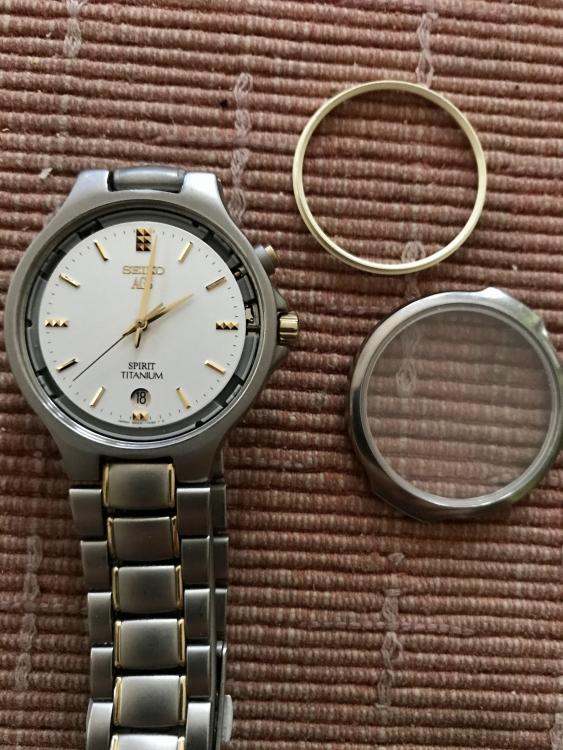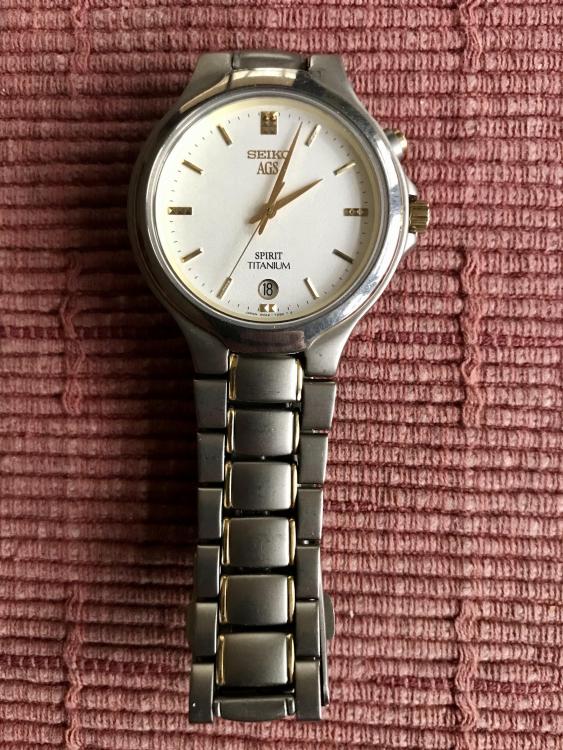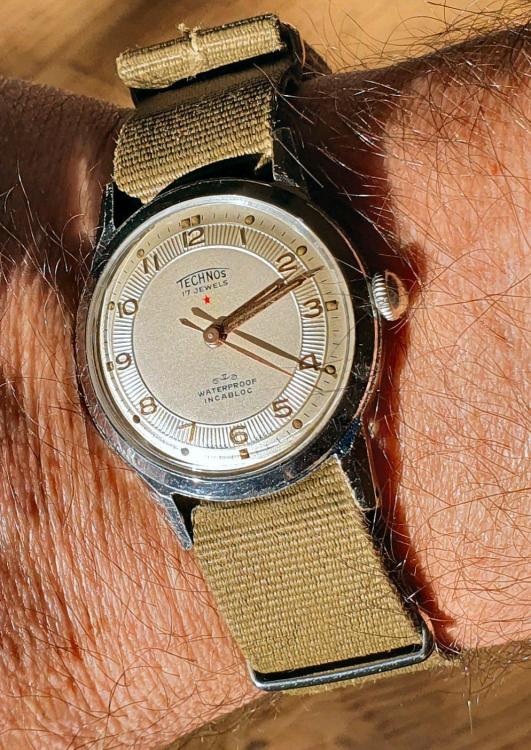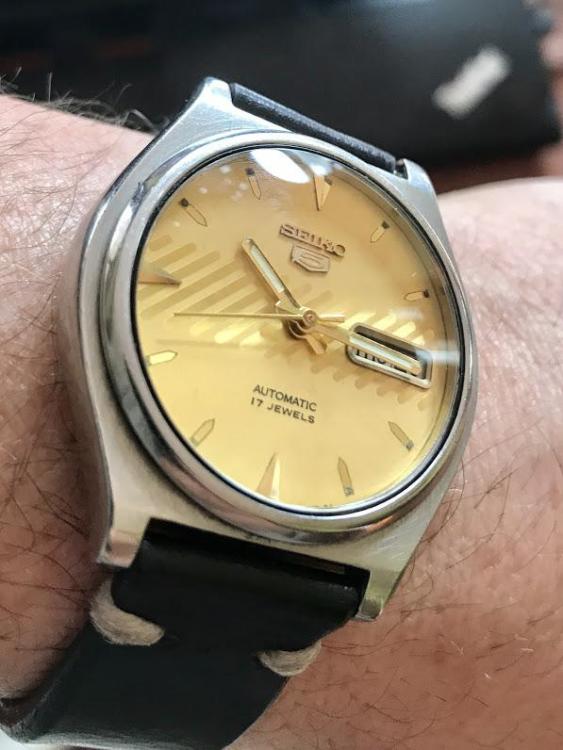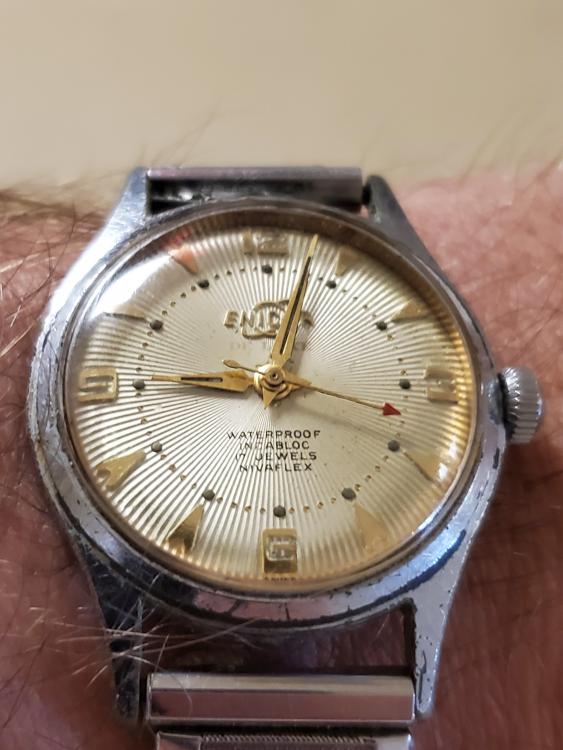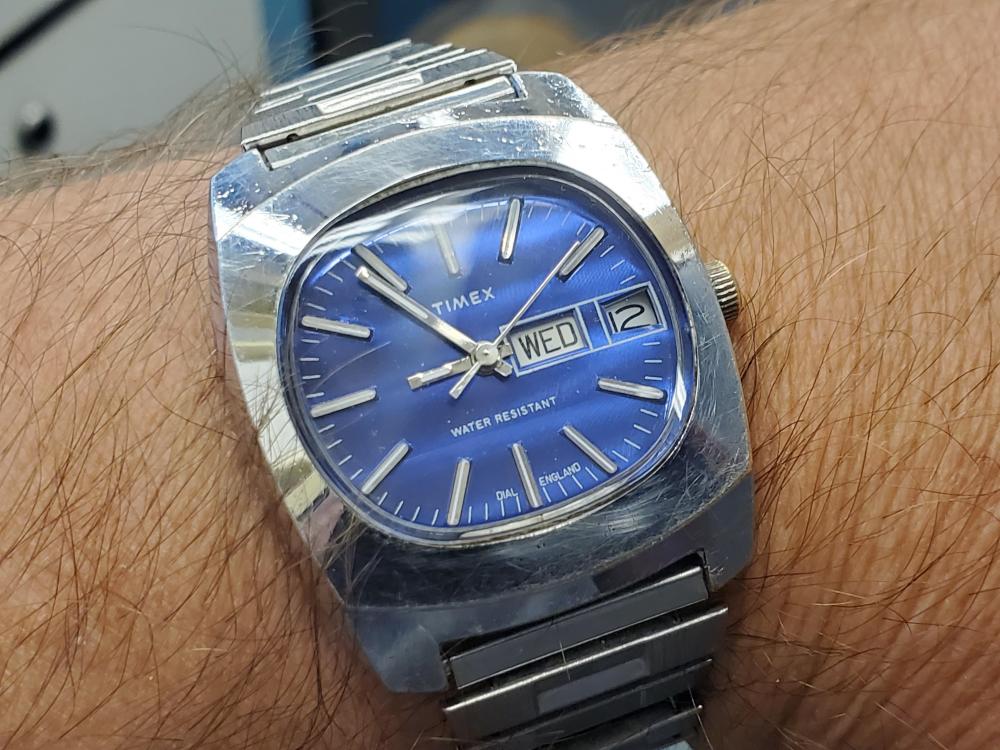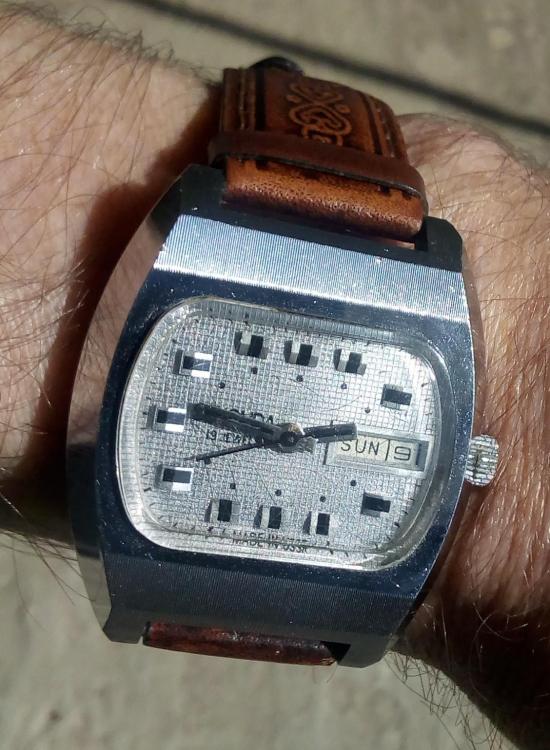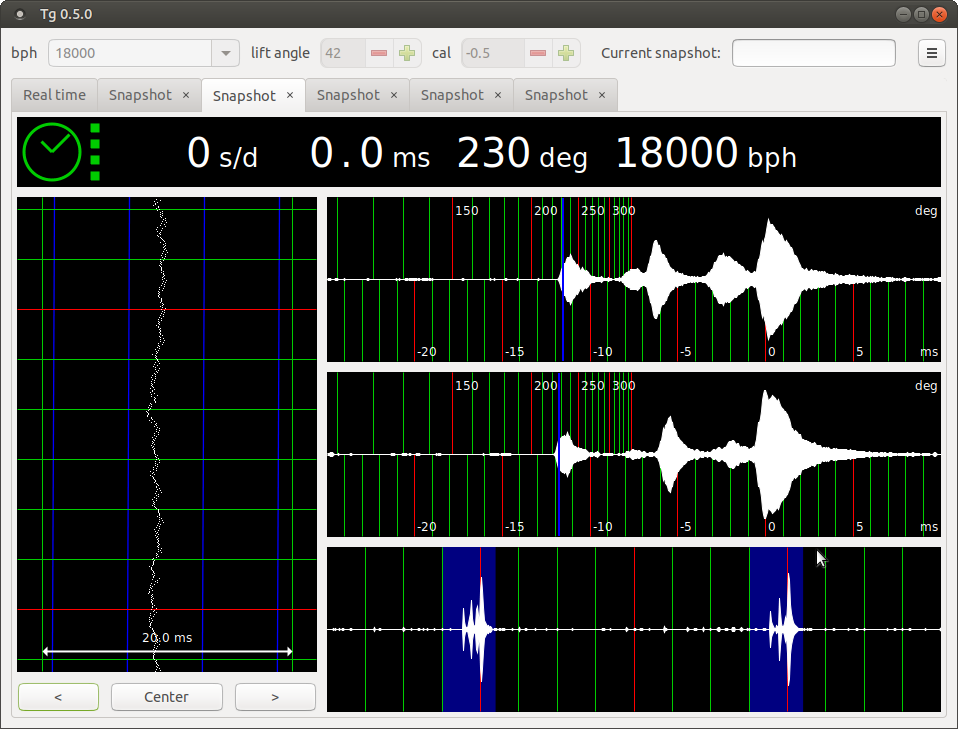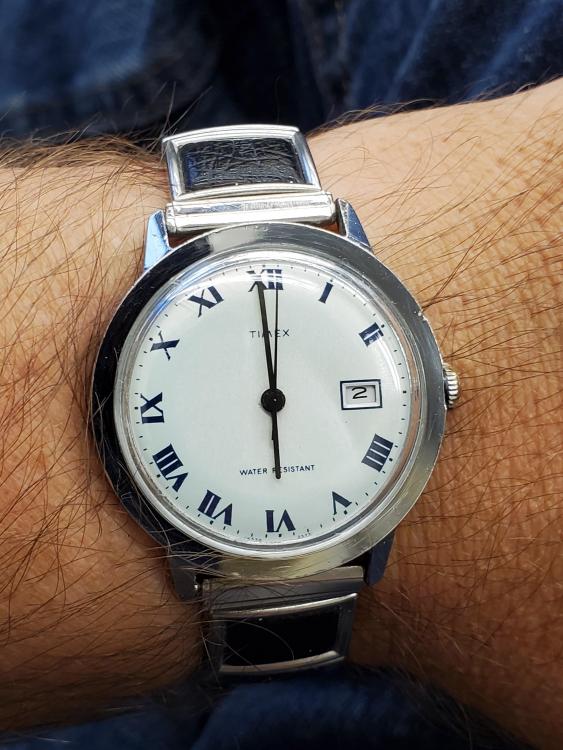Leaderboard
Popular Content
Showing content with the highest reputation on 03/10/20 in all areas
-
If you post a picture of the movement and the problem part(s) we may be able to talk you through where everything goes.3 points
-
On the "testing strap" today, the fruits of last night's labours. A late fifties or very early sixties Timex Model 22 Marlin. This one predates the use of reference numbers on the dial (introduced in 1963 I think), but does have "Scotland" stamped on the mechanism, and a Dundee accent to its tick. It seems to be running well, but will require a slight correction to shift the -120 sec/day or so back to something more respectable. I'm not looking forward to that, as its mechanical brain needs to be extracted from the front of the case without marring the dial or the crystal. I can see why they dropped this approach in favour of a two part case, and why the changed the design away from the M22, as it is pretty temperamental to work with.3 points
-
2 points
-
There is no silicone present on the gaskets that I buy, these come dry. I don't have the chemical equipment to find if perhaps there is an infinitesimal amount. A proportionate amount on grease may marginally help water resistance especially on the crown that is the weak point of single-seal systems like on the Seiko SKX, but cannot do much when subjected to pressures of just 3 or 4 bar, that is the job of good synthetic rubber. Of course to verify water resistance one has to use a device, but if work is done meticulously and the materials are good, there is 99.9% confidence that it will be safe for snorkeling, air diving, etc. For the record the material (NBR) commonly used on watch gaskets do resist to mineral oils, fuels, any many more agents https://en.wikipedia.org/wiki/Nitrile_rubber2 points
-
Do not ream it out. The reason that there are no crimp marks is because the friction coupling in this set up is not via a crimp that grips the center wheel pinion, but via those two parallel spokes in the wheel that is attached to the bottom of the cannon pinion which run in a groove in the cannon pinion, gripping it to provide the friction coupling. A touch of D5 or HP1300 in the coupling groove should help. It's also worth making sure that it is really clean first as an accumulation of old dried oil in the groove could be gluing things up.2 points
-
As @Graziano said there are 3 rectangular holes in the edge of the mounting to facilitate the flow of cleaning solution. The trouble is that when the oil you're trying to shift is very congealed and you can't get a brush or peg wood in to dislodge it, simply soaking won't work unless you're prepared to do so for a very long time (try weeks!!). What you could try though is forcing cleaning solvent through the setting using a syringe of the type you get for re-filling inkjet cartridges after a good soak to soften the gunk. Place the tip of the needle into the hole jewel so that the solvent flushes through the setting, taking the gloop with it.2 points
-
I think this is what is known as a rubbed jewel. If so you can remove the jewel using a jeweling press and once the jewel has been cleaned you can then rub the jewel back in using a rub in tool. Mark has a vid showing the replacement of a damaged rubbed in jewel see below. HOWEVER I would not (if it was me) attempt without the correct tools. A really good soak and if you have not got a ultrasonic cleaner then use a blower to clear the dirt.2 points
-
Hi there that type of jewel setting has 3 holes around the outside edge for cleaning solutions to penetrate ,it looks like a shock spring goes in there but it doesn't you can soak and do as you say with ipa ,give plenty of time to dry .You can also gently clean hole with pegwood but don't break the end off or you will have to press the setting out ,which is another way of cleaning it if you have a jeweling press . A good soak and a peg then rinsed and oiled it should be good as gold .Hope this helps2 points
-
Fair point! ...... Well I saw on a Ulysse Nardin video a operative enamelling dials with what appeared to be a pizza oven.... So I just thought...... Its Horological/Liberty Hall here. I'm wondering if I use a smaller hammer I could fit the replacement crystal utilising a similar methodology ..... I guess its more a gradually increase of pressure as against a short sharp shock..... Using weights perhaps...... Or my foot? This all started by me needing a battery replaced & now look!2 points
-
Hi there ,I think what jdm means is they don't apply silicon the same way .Replacement rubber o rings always come with a bit of silicon applied from the factory where there made so that they don't dry out or tear when screwing down the caseback, also as jdm states to hold the gasket in place . Always good practice to add a bit more with a sponge applicator to be sure when putting a replacement gasket in as rodabod states to fill voids for waterproofness . Hope this helps2 points
-
Hi there ,just a little reminder for enthusiasts and diy maybe not the pros ,anyway I got 2 watches today for a service ,firstly a seventies mortima dive watch and a 1920s elgin grade 292 hunter pocket watch . Well it looked like the dust cover on the pocket watch had been opened by everything from a crowbar to an axe what a mess .The mortima had the bezel bent and huge scratches where someone had tried to take it off . Please use the right tools to open casebacks ,remove bezels ( no caseback knife ) use bezel remover ,and sharp blade for dust covers . Have an assortment of snapback tools as these are the easiest to damage . Remember to achieve perfection one must leave the timepiece if one can in better condition than when one received it1 point
-
I agree with that. But it can't be wear since it's a new watch. I'd be curious to see a timegrapher picture.1 point
-
Hairsprings coil, should be flat, level and concentric. It looks unlevel and not concentric in the picture, likely to touch the main plate. Luckily, It looks undamaged though, perhaps the regulator are in pushed down causing the coil to sit oblique. Check what is causing the hairsprings to sit unlevel, it will time fine once hairsprings is sorted out. Perhaps the picture did not open for OH.1 point
-
Large family so a HS off of any member would vibrate with this. Don't know if any member did beat more than 18000 though.1 point
-
1 point
-
That looks remarkably clean and shiny for something that left the factory in Japan the best part of 45 years ago. They are very solidly built, and that dial is very clean and sharp. Those who say the seventies was the decade that taste forgot, evidently didn't see that little beauty.1 point
-
1 point
-
Usually, but not always, train wheels that are used with cap jewels will not have a pivot with a shoulder, they will look more like balance pivots. If you want to replace with a normal hole jewel you need to verify that the pivot will work; if it doesn't have a square shoulder it won't.1 point
-
That is excessive and strange play, possibly a lose cannon pinion. It doesn't seem that the entire mov't is moving by looking at the date, which doesn't move. Either have it inspected by a reputable watchmaker or return it to the seller. If they raise any objection just open a claim with PayPal or the CC issuer and let them handle.1 point
-
To me this looks like a simple two piece case. The "gash between the lugs" is actually put there by the case maker to provide a starting point for inserting a case knife. It looks slightly deformed probably due to the use of inappropriate tools being used to open it in the past. This also suggests that the metal is fairly ductile, and given the style and colouring of the case, that it is solid gold rather than plated. I would not be in the least bit surprised if you find it hall marked inside the case back when you get it open. The split between the case upper and back can be clearly seen extending from each end of the gash and around the edge of the case and through the center of the stem, which means that this is unlikely to be a two piece stem as once the bezel has been removed the movement will simply lift straight out. If it is very tight try starting with a single edged razor blade pushed into the split between the two case halves. Just push it in, don't twist. This will hopefully open the gash enough to allow a case knife to do the rest. Whatever you do though take great care not to slip and slice you fingers, and bear in mind that if I'm right about the gold, it will mark quite easily.1 point
-
Actually, I think you are the first !!!! Unless other members would like to come forward1 point
-
Everyone has their own style...and they seem to work for the most part. For me, if the watch is really dirty I will plonk the whole movement into the ultrasound (minus calender wheels and any other plastic bits). This get rid of most of the crud. I then follow my normal routine of hand cleaning in lighter fluid etc. I wouldn't depend on a watch cleaner to get all the crap out as its basically in a blind hole and stuff may vibrate loose but still be in the hole. That's what I do...give the various suggestions here a try and decide what works best for you. Anilv1 point
-
My cleaning machine was made by Greiner, in the late 60s and made till sometime in the 70s. All the parts are strung on wires in what we call the "Christmas tree", any parts that can't go on wires go in a little basket. The balance and fork are supposed to go on a separate tree stacked on top. After cleaning the top tree with balance and fork go in the ultra clean alcohol to rinse for 15 seconds, then the rest goes in and the rise gets dumped and then refilled from the distiller. It's fabulous. In practice I leave the shock protected balance on the mainplate and fork in the little basket. Modern balances have the roller jewel press fitted so no problem there, and 7/10 watches I adjust the escapement so I'll reshellac anyways. But a quick rinse in alcohol will not hurt shellac; if the alcohol is ambient temp you can do several minutes no problem. In my machine it's always very warm and if I'm busy and leave it it's likely to at least degrade it. My escapement heater is almost always on (and kudos to Bergeon, solid piece of equipment!) so 30 seconds to reflow/add shellac if necessary.1 point
-
1 point
-
Hi there , it will be ok for this purpose for rubber o'rings only ,best applied with foam applicator ,being for scuba equipment it would have good anti washout properties . Hope this helps1 point
-
Thank you! I ended up ordering this one https://www.amazon.de/dp/B019CNE7TK/ref=sr_1_40?dchild=1&keywords=silikonfett&qid=1583797883&sr=8-40 . Looks like it is used in diving equipment. They do not specify anything, other than call it silicon grease (silikonfett) and it's made in germany. Please, let me know if this was a mistake.1 point
-
I don’t recommend using that grease made by Anchor as I don’t believe it is silicone grease and may cause deterioration of gaskets if it is mineral oil based. If you’ve ever used a waterproof tester then you’ll appreciate that grease can help waterproof-ness. It can fill in voids. And also helps to stop the gasket displacing on screw-down backs.1 point
-
Thank you all for being so kind and helpful it's been greatly appreciated, I've been on many forums for various things over the years and it's nice seeing people welcoming newcomers with out being rude, I have a old pocket watch I am going to attempt to disassemble and take images of every step so I can back track. Thanks again for all the great tips it has been very helpful1 point
-
Watch WatchGuy.co.uk using it, it's really that simple! The only thing to care is to stick the jewel firmly enough on the tool tip so it doesn't fall when you touch it with the oiler.1 point
-
Good to know! It also is a magnet for dust, I clean it every now and then just with watter. I never dared to open them. I clean diafix assembled on the plate/bridge and try to oil thru the hole. Not the best practice I know, but that's all I can do1 point
-
Hi Gary Thats an odd ball, without looking at the watch the only thing i can think off is its in upside down and the arbour is as well. I feal that the only recourse is to remove the spring again and double check both the barrel wall for the anchor point and the fact that will the arbour fit in upside down. When you get a spring in its holder one side is coloured and the other is plain I seem to remember the coloured side is uppermost when pressing in the spring. a lot of work I know but when something dosen't work is then back to basics.'1 point
-
It is pretty hard to set the time. It must be something wrong with the module. And I noticed that teeth of the date ring is almost missing! And the date corrector and yoke...... I browsed the intercharge list on JulesBorel. These also can be found from BFG 582. But both are rare calibers in Chinese market...... I am searching Internet...... A day-date BFG 628! From the technical document on Cousins, parts I need (2566, 2566/1, 2557/1) look like the same. So I bought this immediately and I am waiting for 4 days delivery...... Continued1 point
-
Today we have a Chromatic EB8807 "Digital" probably from around the same period as the previous Keinzle stopwatch/chrono. Hamilton produced their first LED "Pulsar" in 1971 (for a whopping $2,100.00 - the price of a small car at the time). These "digitals" were designed to have the look and feel of an LED watch, but without the eye watering price tag. This Chromatic actually changes its appearance slightly depending on the light, which I guess was an attempt to further emulate some of the novel appeal of the LED display. The effect is quite subtle, and I doubt it would fool anyone, since it is entirely passive, and down to the choice of colours used on the dial. This watch arrived in a pretty tatty condition "overwound", in other words in need of a clean, but once cleaned and serviced it has scrubbed up to look almost new. It feels pretty huge on the wrist, although most of the case is empty space, as the EB8807 mechanism sits in a large, offset plastic holder. As you can see from this Rannft picture of the mechanism there is a lot of empty space to fill to make up for those large numeral disks. The 18mm case lugs and narrow strap have the effect of making the case look even larger, so it would appeal to the modern "dinner gong full of fresh air on the wrist" design aficionados. All in all, strangely, I actually like it. It exudes 1970s charm by the bucket load.1 point
-
1 point
-
Be reassured all of these are the same and it won't make a difference. Rather if you want an easy task and uniform film get a sponged applicator. Also note that especially on the case back gasket is the O-ring that makes it waterproof, not the grease, which is there mainly to keep it in place and peace of mind. It is not even used by the factory.1 point
-
1 point
-
1 point
-
Hi I've been wearing a couple of recent incomings! Dan henrt 1963 Pilots Chrono, It has the SR71 Lockheed Blackbird on the case back! This is number 0348 of a run of 1,963 pieces Also been alternating bewteen this Dan henry 1968 Dragster chrono This one is number 0318 of 1,968 pieces.. John1 point
-
1 point
-
I have replaced the capacitor in this JDM Seiko AGS Spirit Titanium (5M22 movement). This is a one piece case, so the bezel has to come off to get to the movement. The bezel gasket was a bit hard to get back in (ordered two new ones and ruined one), but it all went in on the second attempt (using a drill press. Yes, I am a newb and do not own a crystal press. But I have other tools and am resourceful). Here it is. I really like this watch. It's very well made, the titanium case and band make super-light and very comfortable watch. The crystal is most likely sapphire, though it does not say so on the back. I did look up the Seiko catalog and it calls for sapphire replacement part. Also, for a watch this old (from the early-mid 90's) the crystal is literally pristine. No scuffs or scratches. Very high quality piece that I am really enjoying right now. The new style capacitors (LiOn batteries, really) allow about a 4 month reserve on these. I am very happy with the purchase and the "service" I gave it. Before serivice b After service1 point
-
Today it's a mid to late '50's Technos, fresh from the bench..... Please pardon the confusing shadows on the dial, we had a rare moment of sunshine which had to be taken advantage of. Picked up for a song, minus crown and stem and in a typically scruffy state. After a full service including new main spring, crystal, case back gasket, and of course the missing parts replaced, it's running like a champ.1 point
-
Back in "sunny" Perthshire after our India trip. Back to floods, snow and high winds (and an exciting flight in to Edinburgh last night in a Dash 8 Q400 in "marginal" conditions), so I swapped my favorite little workhorse 19 jewel Sekonda TV face, (which performed flawlessly I might add), for something a little more sunny. A bright champagne dial "Crown Watch" with gold hands. Now I'm about to take advantage of a lull in the weather to take a quick look round the garden and see what is still there, and what has been washed away or blown down.1 point
-
Today I am enjoying this Seiko 5 (7009 movement). I bought it for almost nothing and it really didn't need much. The crystal was in bad shape and I replaced it with a magnifier (like that look and this watch does not have to be 100% original). The lume on the hour marks is gone, hands still glow fine. This thing moves right along and keeps excellent time.1 point
-
1 point
-
1 point
-
1 point
-
This Swissie was in the same batch with the Seiko Bullehead that I've presented recently. Very wearable at 39.5mm and well equipped with a SW200 mov't. Seller classified it as a junk just because the balance had over banked, as I eventually found, definitely a deal for €144 inc agency fees and shipping. Runs as a charm and will be in two minds about keeping it or not.1 point
-
I've just 'discovered' early Timex watches, though all of mine are electric or very early quartz ones....1 point
-
1 point
-
On the theme of watches enjoying a bath, here is a quick video of a Timex getting the "Duncan Slunge" treatment. The jar is actually a single portion jam pot, picked up with my scone and jam from the local supermarket Cafe. This is a 1967 Timex mechanism watch mechanism soaking, and also, if you look carefully, ticking away nicely in cleaning fluid. Generally it is advisable to remove the hands, and dial, but In this case I didn't bother. The service manual also suggests removing the balance, but that is generally not necessary, and introduces the risk of damaging the hairspring or putting the balance way out of beat. This is not perhaps the most subtle method of cleaning a watch mechanism, but with these vintage pin lever Timexes it does typically work. The "bath" is naptha, aka lighter fluid. Around five to ten minutes is usually sufficient to dissolve and remove the old dried up oils and dirt, but some really grubby examples may necessitate a couple of trips through the bath, or may even require complete disassembly. Any rust or corrosion must be attended to separately. CAUTION: Do not try this on any expensive watches, (i.e. pretty much anything other than a vintage Timex mechanical). You can clean other watches with naptha, but much greater care is needed. Also be aware that the naptha may attack glue, dial finishes, seals and jewel settings on jeweled watches. Soaking jeweled watch balance components in any form of alcohol should be avoided. On jeweled watch balances and balance forks, it will quickly dissolve the shellac and may destroy the balance or fork (naptha is generally safe for short periods on these items). Also be aware that lighter fluid is obviously a fire hazard, as well as being toxic and an irritant. Take suitable precautions to avoid inhaling or even touching the stuff as much as possible. Once soaked, and dried, you should lubricate the mechanism in accordance with the relevant Timex service manual, which are almost all available on line. Dry the movement on some clean cloth or similar, prior to lubrication but try to avoid anything that will shed fibers into the mechanism. You can use a fan heater or hair dryer to speed up the drying, but remember that this stuff is designed to be used in a cigarette lighter, so don't set things on fire. You should use a good quality watch oil, but I have to confess that for fun I have tried 0W30 motor oil, and it appears to work just as well. Apply any oils very sparingly, otherwise you will gum up the works. The tiniest spot of oil is all that you need. Just enough to cover the moving surfaces of those tiny pinions, and no more. DO NOT USE WD40 or similar penetrating oils, they are terrible for this application. They may also damage the dial finish, and cause the acrylic crystal to "craze". Don't use them.. just ... don't. They may be good for removing rust from your mountain bike, or for un-seizing the frozen wheel nuts on your 1976 Volkswagen, but penetrating oils are terrible as a watch lubricant. Do not get any oil on the hairspring, or the coils will stick together and the watch will either run very fast, or not at all. If you do have an issue like this, simply re-soak in naptha and this should remove the oil from the hairspring. Finally, all of this advice is offered as is, you do this entirely at your own risk.1 point












